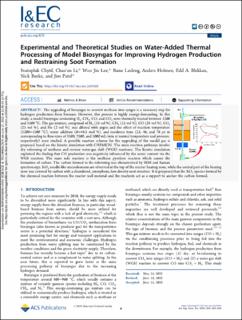| dc.contributor.author | Chytil, Svatopluk | |
| dc.contributor.author | Li, Chao'en | |
| dc.contributor.author | Lee, Woo Jin | |
| dc.contributor.author | Lødeng, Rune | |
| dc.contributor.author | Holmen, Anders | |
| dc.contributor.author | Blekkan, Edd Anders | |
| dc.contributor.author | Burke, Nick | |
| dc.contributor.author | Patel, Jim | |
| dc.date.accessioned | 2022-08-05T12:34:04Z | |
| dc.date.available | 2022-08-05T12:34:04Z | |
| dc.date.created | 2022-06-27T13:57:13Z | |
| dc.date.issued | 2022 | |
| dc.identifier.issn | 0888-5885 | |
| dc.identifier.uri | https://hdl.handle.net/11250/3010376 | |
| dc.description.abstract | The upgrading of biosyngas to convert methane into syngas is a necessary step for hydrogen production from biomass. However, this process is highly energy-demanding. In this study, a model biosyngas containing H2, CH4, CO, and CO2 were thermally treated between 1200 and 1500 °C. The gas mixture, comprised of H2 (33 vol %), CH4 (12 vol %), CO (28 vol %), CO2 (25 vol %), and He (2 vol %), was diluted with argon and the effect of reaction temperature (1200–1500 °C), water addition (0–44.3 mol %), and residence time (23, 46, and 76 μs in corresponding to flow rates of 1500, 2500, and 5000 mL/min at normal temperature and pressure, respectively) were studied. A possible reaction scheme for the upgrading of the model gas is proposed based on the kinetic simulation with CHEMKIN. The main reaction pathways involve dry reforming of methane and reverse water-gas shift (WGS) reactions. The kinetic simulation explained the finding that CO production was negatively influenced by the water content via the WGS reaction. The main side reaction is the methane pyrolysis reaction which causes the formation of carbon. The carbon formed in the reforming was characterized by SEM and Raman spectroscopy. SiO2 needle-like microdomains are observed at the top of the reactor heating zone, while the central part of the heating zone was covered by carbon with a disordered, amorphous, low-density soot structure. It is proposed that the SiO2 species formed by the chemical reaction between the reactor wall material and the reactants act as a support to anchor the carbon formed. | en_US |
| dc.language.iso | eng | en_US |
| dc.publisher | American Chemical Society | en_US |
| dc.rights | Attribution-NonCommercial-NoDerivatives 4.0 Internasjonal | * |
| dc.rights.uri | http://creativecommons.org/licenses/by-nc-nd/4.0/deed.no | * |
| dc.subject | Syntesegass | en_US |
| dc.subject | Synthesis gas | en_US |
| dc.subject | Water | en_US |
| dc.subject | Hydrocarbons | en_US |
| dc.subject | Chemical reactions | en_US |
| dc.subject | Animal feed | en_US |
| dc.subject | Addition reactions | en_US |
| dc.title | Experimental and Theoretical Studies on Water-Added Thermal Processing of Model Biosyngas for Improving Hydrogen Production and Restraining Soot Formation | en_US |
| dc.title.alternative | Experimental and Theoretical Studies on Water-Added Thermal Processing of Model Biosyngas for Improving Hydrogen Production and Restraining Soot Formation | en_US |
| dc.type | Peer reviewed | en_US |
| dc.type | Journal article | en_US |
| dc.description.version | publishedVersion | en_US |
| dc.rights.holder | Copyright © 2022 American Chemical Society | en_US |
| dc.subject.nsi | VDP::Kjemisk prosessteknologi: 562 | en_US |
| dc.subject.nsi | VDP::Chemical process engineering: 562 | en_US |
| dc.source.pagenumber | 9262–9273 | en_US |
| dc.source.volume | 61 | en_US |
| dc.source.journal | Industrial & Engineering Chemistry Research | en_US |
| dc.source.issue | 26 | en_US |
| dc.identifier.doi | 10.1021/acs.iecr.2c01680 | |
| dc.identifier.cristin | 2035449 | |
| dc.relation.project | Norges forskningsråd: 228741 | en_US |
| dc.relation.project | Norges forskningsråd: 257622 | en_US |
| cristin.ispublished | true | |
| cristin.fulltext | original | |
| cristin.qualitycode | 2 | |

